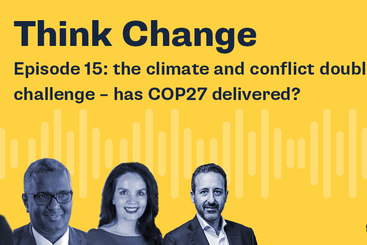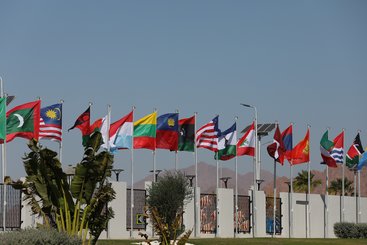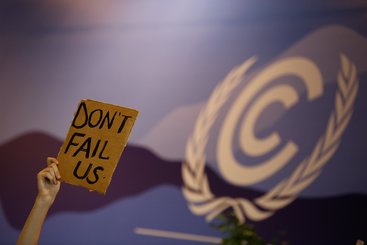The latest UN climate conference was a demanding two-week event which yielded mixed results. While the final deal agreed at COP27 failed to raise ambition on tackling the causes of climate change, the ‘Sharm El Sheikh implementation plan’ did include some steps forward for addressing climate change impacts.
A new fund for loss and damage
The decision to establish a new loss and damage fund has been applauded by developed and developing countries alike as the one resounding success of COP27. But it’s taken thirty years to get here – a long time in international diplomacy – and the hard work has only just begun. Those people working to operationalise the fund will need to decide how it can simultaneously deliver post-disaster assistance quickly, without increasing levels of debt, while also providing finance to support displaced communities and to restore depleted ecosystems. Perhaps the hardest decision for the fund will be how to ensure “equitable and targeted support”: essentially, deciding which developing countries are particularly vulnerable to the adverse effects of climate change and are therefore in greater need of loss and damage finance.
For more ODI expert insight into loss and damage:
Any acknowledged responsibility for loss and damage caused by climate change will only have meaningful effects when countries redress them. For the sake of the smallest, most vulnerable nations on earth, it’s high time that they did.”
- Emily Wilkinson, Senior Research Fellow, ‘Why a chain of tiny Pacific islands wants an international court opinion on responsibility for the climate crisis’, The Conversation
Setting targets for climate change adaptation
Meanwhile, in another negotiating room, progress was made towards developing a Global Goal on Adaptation (GGA). The GGA, which aims to provide a system for tracking and assessing countries' progress on adaptation actions, is spelled out in the Paris Agreement, but without detail on how it will be achieved or measured. Developing countries are keen to have a common interpretation and way forward on the GGA which increases ambition and financial support for adaptation – in the same way as the 1.5oC warming limit provides that impetus for mitigation. But they have been frustrated with slow progress to date under the Glasgow-Sharm-el-Sheikh Work Programme on the GGA (GlaSS), which is meant to define how adaptation progress worldwide is measured – in the context of the Global Stocktake. The G77-plus-China bloc successfully negotiated an outcome that will provide greater structure to the GlaSS in 2023. All mention of global targets was excluded from the final text, but this can’t be avoided much longer. African nations (with large populations) are keen to see a global quantified target – such as numbers of resilient people – while Small Island Developing States (with small populations), would prefer a mix of quantitative and qualitative targets, potentially aggregating national targets.
For more ODI expert insight into climate change adaptation:
Financing a just transition
The finance needed to transform the world to low-carbon, climate-resilient pathways is still very far from being met. Not only are developed countries failing to provide the agreed $100 billion in climate finance per year to support developing countries adapt to and mitigate climate change, but existing resources often fail to reach local communities and conflict-affected areas. But as ODI unpacks in a blog post for the Climate and Development Knowledge Network (CDKN), COP27 saw a number of important discussions around the need to finance the low-carbon transition in developing countries. This included Barbados Prime Minister Mia Mottley’s Bridgetown Initiative, which calls on the International Monetary Fund to free up low-cost, long-term capital to borrowers following climate disasters.
On the back of these discussions, one of the most notable steps forward for climate finance at COP27 was the text urging a reform of multilateral development banks and other international financial institutions. The final text “calls on multilateral development banks to contribute to significantly increasing climate ambition” and on the shareholders of these banks and international financial institutions to reform their practices and priorities to better address the global climate emergency. President Emmanuel Macron of France has agreed to co-present the proposals with Prime Minister Mottley to the World Bank and IMF ahead of their Spring 2023 meetings, a sign of increased multilateral attention.
For more ODI expert insight into finance for climate change adaptation:
“Current adaptation approaches and planning are more suitable for stable areas; they do not fit the compound crises and conflict histories of fragile areas… [But] We cannot rely on humanitarian finance as the sole response to climate-induced crises. We need to scale up anticipatory action, and implement long-term investments for disaster risk reduction and adaptation to protect people's lives and livelihoods in the face of current and future disaster and climate risks.”
- Rebecca Nadin, Director of Global Risks and Resilience at ODI, speaking at a COP27 event on anticipatory action in conflict-affected states
Missing pieces
Against the backdrop of a food crisis, COP27 was the first UN climate conference to devote a whole day of the negotiations to agriculture. However, while the conference shone a spotlight on the urgent need to transform agriculture and food systems to mitigate, and increase resilience to, climate change, there have been few measures to respond to the current food crisis factor in climate and environmental impacts. This ODI Insight looks at what can be done differently and how the UNFCCC process can contribute.
There was also a mix of progress and backsliding on diversity and inclusion in climate policy-making at COP27, as ODI covers in a blog post for the CDKN. On the positive side, young people were very much a part of the UNFCCC process this COP. COP27 was the first to have a youth-led climate dialogue, with several young leaders taking to the stage to call for greater climate ambition. Prior to the main COP, a ‘Youth COP’ trained more than 1000 young people in negotiations, and 27 of these people went on to join their national delegations.
As regards the inclusion of women in the climate change negotiations, women struggled to gain representation on national delegations (actually backsliding on progress of previous years): fewer than 34% of climate negotiators at COP27 were women.
Most disappointingly, while the ‘just transition’ - the idea of moving to a more sustainable economy in a way that is fair to everyone – was a key theme of the Egyptian COP27 Presidency, gender featured nowhere in the COP27’s just transition decision, nor in the just transition text of the overarching Sharm El Sheikh Implementation Plan. This is critical, because society’s responses to climate change carry the risks of reinforcing existing forms of disadvantage and discrimination, unless they are intentionally designed to be inclusive. A decade of mixed success with REDD+ schemes (reduced emissions from deforestation and forest degradation) has revealed how poorly informed ‘carbon projects’ can undermine the wellbeing of local communities, especially local women.
For more ODI expert insight into social diversity and the just transition:
“Much attention by countries to date has been on transition plans for the male-dominated workforces of fossil fuel extractive industries. There is a need for focus on women, especially rural women in the global South, who face dislocation from natural resource access (even dispossession), as land is repurposed for other uses. Solutions must be forged in partnership with them and in protection of their rights to decent work, food, nutrition and health.”
- Mairi Dupar, Senior Technical Advisor, ‘COP27 offers mixed news for social inclusion in climate policy’, CDKN
For more ODI expert insight into integrating food systems into the UNFCCC process:
"Few publicised responses to the food crisis have addressed the connections [between agriculture and climate change], and measures to tackle underlying climate and environmental drivers of the food crisis are far and few between. Worse still, many short-term responses run the risk of reproducing, entrenching and amplifying structural fragilities in the food system, undermining future food security…. Agriculture and food systems need to have a strong formal representation within the UNFCCC process.”
- Anna Locke, Senior Research Associate, ‘Putting food systems at the heart of climate dialogue and action’, ODI






